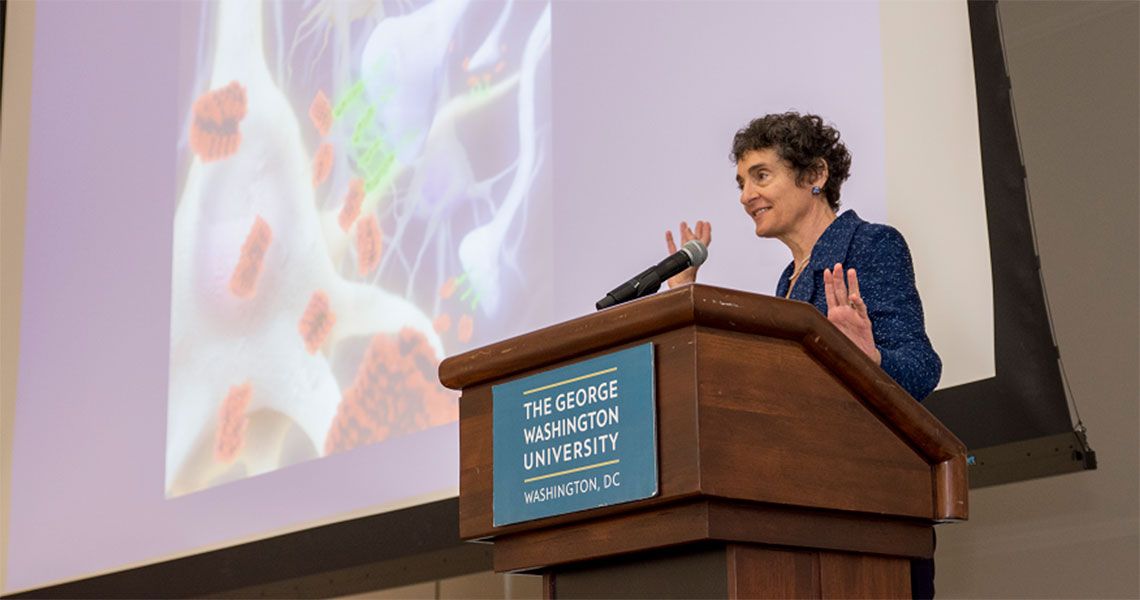Neuro-immune diseases — particularly Alzheimer’s, multiple sclerosis (MS), and myasthenia gravis (MG) — took center stage at the Sixth Annual Neuroscience Symposium, a day-long event sponsored by the GW Institute for Neuroscience (GWIN). Themed “The Neuro-Immune Interface: Glia, Neurons, and Disease,” the symposium featured two keynote speakers, as well as presenters from the GW School of Medicine and Health Sciences (SMHS) and Children’s National Health System (Children’s National).
“This [symposium] is a wonderful thing to do,” said keynote speaker Carla Shatz, Ph.D., Sapp Family Provostial Professor, David Starr Jordan Director of Stanford Bio-X, and professor of biology and neurobiology at Stanford University.
Shatz’s research, “Saving the Synapse: Developmental Critical Periods and Alzheimer’s Disease,” boiled down to one key theme: pruning.
“My lab has always studied — and still studies — how neural activity and visual experience tune up brain circuits during critical periods of development,” she said. “So, what the heck is a neurodevelopmental scientist doing studying Alzheimer’s disease? The answer really is ‘it’s all about pruning.’”
The idea, she explained, involves synaptic pruning. More specifically, if researchers could better understand the cellular and molecular mechanisms underlying developmentally critical periods, then they could re-engage those mechanisms in the adult brain to help repair or improve cognitive enhancement.
While Shatz discussed possibilities for Alzheimer’s, the second keynote speaker, Stephen L. Hauser, M.D., Robert A. Fishman Distinguished Professor and chair of the Department of Neurology at the University of California – San Francisco, focused on MS.
“Over his career, Steve has spanned the spectrum through thinking about the molecular biology, the gene expression, the epidemiological approach, and the therapeutic developments for patients with MS,” said Robert Miller, Ph.D., senior associate dean for research and Vivian Gill Distinguished Research Professor at SMHS.
“Bench to bedside and back,” called Hauser as he made his way to the podium.
As Hauser explained, his story, which he presented as part of “Multiple Sclerosis: Lessons from the Bench and Bedside,” is 35 years old.
“[It’s a] very long story that is about to finally result in a therapy that just achieved breakthrough status from the FDA [that] we’re confident will be approved later this year and available to our patients,” he said. “It’s a story that goes back and forth from the bench to the bedside and back with each environment informing the other.”
Hauser’s research focused on B cell-based therapies and their impact on the disease, particularly relapsing forms of MS. He found that monoclonal antibodies targeting CD20-positive B cells reduced disease activity within weeks of treatment. “This discovery … enabled a paradigm shift in understanding how the inflammatory phase of MS develops,” he said.
Miller, who presented on new research, “Cellular Interactions Regulating CNS Myelination, Demyelination, and Early Myelin Repair in Vertebrate CNS,” also focused on MS, namely the role of astrocytes, or star-shaped glial cells in the brain and spinal cord, in myelination. Myelination is the creation of the fatty insulation protecting axons.
“We have developed a targeted cell ablation approach that has allowed us to demonstrate a critical role of astrocytes in the timing of myelination,” Miller said.
In addition to the research on Alzheimer’s and MS, Linda Kusner, Ph.D., associate research professor of pharmacology and physiology at SMHS, discussed MG, a rare and debilitating auto-immune disorder that causes muscle weakness. Through her research, she discovered that the expression of the protein survivin could be part of a mechanism that directly impacts autoreactive B cells in MG and other autoimmune disorders.
This year’s symposium also included discussions from SMHS Ph.D. candidates and postdoctoral fellows as well as poster presentations from SMHS and Children’s National researchers.
GWIN, jointly supported by SMHS, the GW Office of the Vice President for Research, and the Columbian College of Arts and Sciences at GW, works in partnership with the Center for Neuroscience Research at Children’s National to facilitate the vital exchange of ideas and to support collaborative neuroscience research and training. The Institute offers seminars, graduate courses, research colloquia, and core services to enhance the scientific endeavors of GW and Children’s National investigators, fellows, and students.



